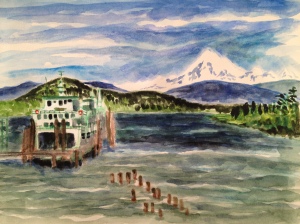
It’s spring on Orcas, in the San Juan Islands, and we are hiking from Cascade Falls via Mountain Lake to Mount Constitution; at the summit, the view of Mt. Baker across the sound is glorious. It is a day so hot and clear, that even Mt. Rainier, nearly 100 miles to the south, sheds the hazy cloak, granting a glimpse of inspiring wonder. The Pacific Northwest has a quality reminiscent yet distinct from the Grand Canyon. Looking across the vast expanse of Puget Sound, we are flotsam in time, humbled by the knowledge that our lives are defined by tides, wind and volcanism; at the Grand Canyon, we witness the passage of time humbled by the expanse of history portrayed by the simple act of water coursing the land. In these moments, when we glimpse our place in the scheme of things, we honor the greater forces at work on our planet.
On the trail, my feet seem to find every small cone shed by the Western Red Cedars populating this coastal forest;* the crunch seems deafening in the stillness. The air tastes salty, tinged by the scent of wood smoke, and the forest is quiet except for birdsong and the infrequent hiker or mountain biker. Rounding the turn, we discover a bald eagle perched on a partially submerged log near the shoreline, fishing. My friend whispers, “amazing to think that the removal of one chemical <DDT> from the environment made seeing this bald eagle possible.”
Today is Mother’s Day, a fitting day to honor women. According to Rebecca Solnit, in the early 1960s three women writers changed our thinking about the nature of authority and tradition in the world into which I was born: Jane Jacobs with The Death and Life of Great American Cities, Betty Friedan with The Feminine Mystique and Rachel Carson with Silent Spring. Jacobs assailed the postwar restructuring of cities resulting in suburbia; Friedan questioned the patriarchy of middle-class suburbia and the assigned gender roles of women; and Carson argued on behalf of ecosystems exposing fatal flaws in Big Science and industry’s broad stroke solutions. As Solnit describes in her essay Other Daughters, Other American Revolutions published in Storming the Gates of Paradise: Landscapes for Politics, Carson was “the first to describe the scope of the sinister consequences of a chemical society, the possibility that herbicides, pesticides and the like were poisoning not just pests – or pests, and some songbirds and farmworkers – but everyone and everything for a long time forward.”
Rachel Carson was able to communicate very technical information and inspire the general public to care about the environment. According to Solnit, Carson’s “book had a colossal impact from the beginning and is often credited with inspiring the DDT ban that went into effect nationwide in 1972. Though some now challenge the relationship between DDT and eggshell-thinning in species, wild birds from brown pelicans to bald eagles and peregrine falcons have rebounded from the brink of extinction since the ban.” Rachel Carson’s closing words say it best “the ‘control of nature’ is a phrase conceived in arrogance, born of the Neanderthal age of biology and philosophy, when it was supposed that nature exists for the convenience of man…it is our alarming misfortune that so primitive a science has armed itself with the most modern and terrible weapons, and that in turning them against the insects it has also turned them against the earth.” Thank you Rachel Carson; your “words are deeds.”** We honor your greater feminine force that gave us this bald eagle today.
* The San Juan Islands forest typically includes Western Red Cedars, Douglas Fir, Western Hemlock, Big Leaf Maples and Pacific Madrone.
** Lord Risley speaking to Maurice Hall from E.M. Forster’s novel Maurice.